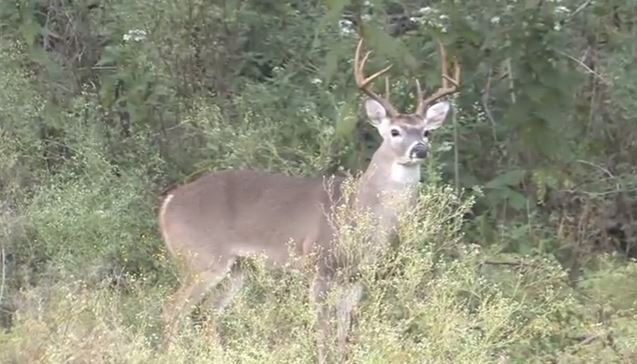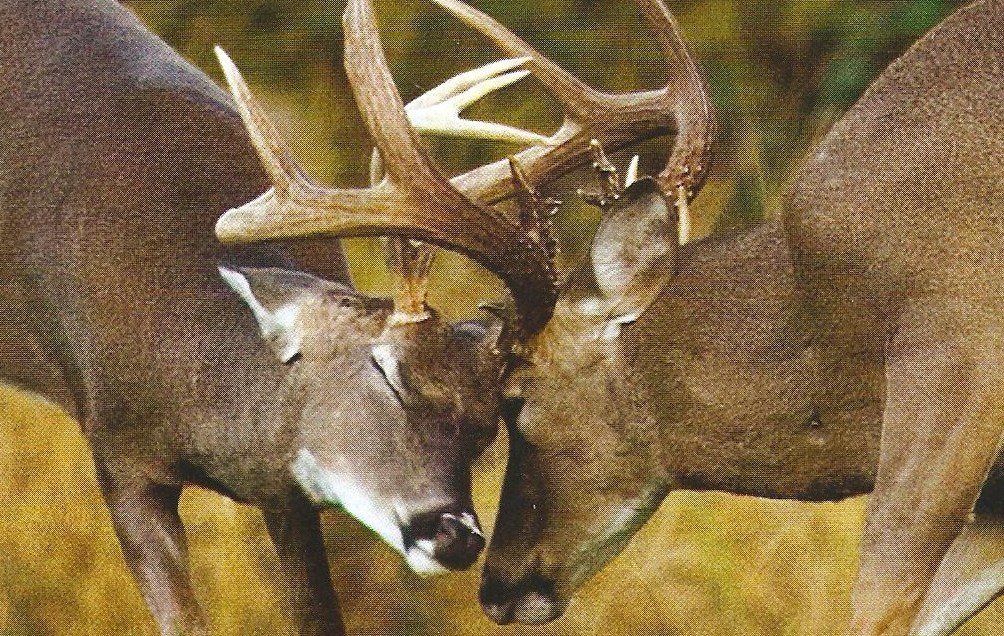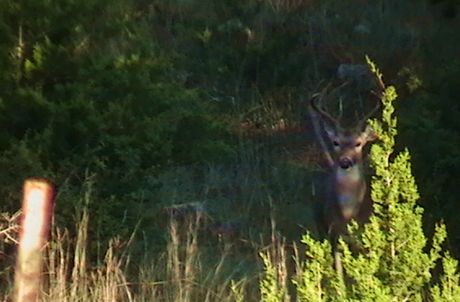Fall is here, food plots are in the ground and the deer hunting seasons are underway. Except for conducting a couple of controlled burns in the near future, the only thing left to do deer management wise for me is to harvest and record the deer we need (or would like) to remove. Though most deer hunters hunt whitetail by setting up over a food source, whether it be a feeder or a food plot, there are much more active ways to bag a buck.
When it comes to hunting there really are only two ways to go: Either you can go to the deer, or you can bring the deer to you.

Rattling for Bucks
Though many hunters have read about rattling bucks in, or have at least seen it on TV, many have yet to give this method of hunting a serious shot. Or maybe you tried it once, but didn’t feel confident, it didn’t work so you packed it in. Ratting for bucks can work, especially if you incorporate the technique into your hunting on a regular basis.
I suspect many deer hunters have picked up a set of shed or cut-off antlers and have at attempted to rattle up a buck, but their lack of success caused them to quickly dismiss the effectiveness of antler rattling. Those antlers then went back to collecting dust at camp. So as effective as rattling can be for whitetail, most of time it will not work and you are not going to bring in a buck on a string. It does work, however, and when it’s hot, it’s hot!
Best Time to Rattle?
Rattling can work at any time during the hunting season, but it is typically most effective just prior to the rut, during the pre-rut. At this time, antler rattling can be an effective way to bring whitetail bucks right up into spitting distance. I’ve seen bucks come running out of the brush with as little as two seconds worth of antler rattling!
Of course many, many times I’ve rattled antlers together only to attract the attention of area squirrels, or even worse, nothing at all. During the pre-rut, bucks are busy establishing dominance for breeding purposes, setting up territories, and working off an excess in testosterone. It is also during this time in which they are most vulnerable to rattling, so this is the BEST time to rattle.
Rattling Antlers Attracts Attention
When it comes to rattling, let me tell you that you never really know what you are going to attract. I’ve had all sorts of deer respond to rattling. I can only guess they all want to run over and see who is fighting — and who will win? Some bucks want to participate, some are just curious. I’ve had does, spikes, middle-age bucks and mature bucks all come to a set of rattling antlers.
All age classes of bucks will respond to rattling more or less at the proportion in which they occur in the population. Younger bucks probably respond at a higher percentage overall and mature bucks probably a little less overall, but it’s not easy to measure since mature bucks are smarter. Older bucks often respond to the sound of rattling antlers by moving downwind of the action and then creeping in. Younger bucks do not always take such precaution, so there is a chance some of those more experienced bucks are detecting us before we detect them.
If a good percentage of the local buck herd is made up of young bucks, then that is probably what you will bring in. If, on the other hand, there are a good number of older bucks in the area, then you have just as a good of a chance of bringing them to you as younger-aged bucks. In fact, you probably have a much better chance of bringing them to you rather than simply sitting and waiting to see them — because they may have stayed “brushed up.”
Rattling, Battling Bucks
A friend of mine spotted a huge whitetail buck last year on public land right as the season started. The buck showed up on a couple of his game camera photos before season, but he got a glimpse of the buck the second day of archery season as the animal walked by at 200 yards. At that point, he then made it his personal mission to hunt that deer for the remainder of the season, even if it meant he ended the year with no buck at all.
To make a long story short, he hunted long and hard with no success, but one cold morning a few weeks later he decided he needed to be more aggressive. He had decided that if he didn’t change then his success rate was not going to change. The best trick in his book: try to get near the buck’s core area and rattle him up for a battle.
The right day came: Temperature perfect, wind great and he was able to rattle that buck to within 25 yards and made a perfect double-lung shot. He said after his first rattling sequence he could see the buck, which scored over 170 Boone and Crockett inches, running at him from over 400 yards! Sometimes it helps to bring them to you.
So rattling can work, but don’t expect it to work every time.


A question to those in the know:
-Does a big bodied basket 6-point buck stay a basket as he ages or will he become a nice wide trophy?
-Do you take this deer out of the herd to improve the future genetics of the herd?
-Will he sire small antlered future bucks?
-Given time, will he mature into a trophy buck which will father better offspring?
Thanks, I look forward to your thoughts!
From my understanding, what you see on a 3 year old buck is what you get. Yes, the deer (if in his genetics) is meant to be heavy then he will gain mass, but not points or much spread. I hunt/live in Alberta and the fields I hunt have great genetics, but if you dont bring in hunters that are willing to take a smaller lesser deer, they just may over run your big buck population.
Remember that big guy can’t be everywhere during breeding season, and the small ones will take advantage of this. My thoughts are bring a first timer out and let them get their hunting start on a deer that you would pass up.
When is the best time to rattle whitetail bucks, September or October?
Adam If you are asking what time of day to rattle…for 2 consecutive seasons I have rattled in 2 shooters just as it was light enough to put my pin on them. One particular 5×5 came in hot looking in a 360 degree area for a fight or a competing alpha buck, needless to say, his antlers are what I started rattling with each season now. Last year, just as the sun was at the top of the lowest tree I rattled about 2 minutes and grunted a few nice tones and a 4×4 came in within 2-3 minutes. I wasn’t expecting him so soon, but he was delicious! I have become paranoid about rattling with my decoy, thinking that once Im settled in, they could be in range and rattling from a tree confuses them if watching my decoy. I now settle in, listen, and rattle if my buck bomb or decoy doesn’t bring some action first. I am a true believer in rattling, I know it works on the aggressive ones, even interested 1-3 year olds. Use your senses of what may already be around before starting your cadence of rattling. Remember that sounds travel early in the AM if its still, and they will come from everywhere to see just what is up with a good rattle. I start of lightly tickling them and gradually move onto more heavy hitting at the end, followed by a few aggressive grunts.
Hi, I am in south west Virginia and I am archery hunting on a small piece of private property. I have tried grunting, doe bleat and nothing. I have nice pictures of some decent bucks and a lot of does on the property. I was wondering if I should try to use a rattling bag to lure the bucks in. Thank you for your time and information.
Mike, there is no rule for this one, but it is a good question. What does matter is how often you are on the property. If you live on a property, for example, deer have become accustomed to seeing you visit certain areas at certain times. In this case, you do not have to stay off the property but probably stay out of areas you are normally out of until hunting season.
On the other hand, if you are rarely on your hunting property, then stay away. Deer are not used to your activity. Anything out of the ordinary will get their attention. I would recommend staying away for a minimum of at least 2 weeks if it’s a small property. On larger properties, you may want to limit activity within a few hundred yards of your stand.
I started rattling in the mid 80’s. I always had bucks run in on me. Today, I only get a buck to come in once in a while. Maybe 1 out of 4 times. There are more deer now then back then so why don’t it work like before? Anyone know?